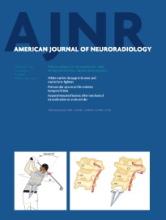Research ArticlePatient Safety
Open Access
Carotid CTA: Radiation Exposure and Image Quality with the Use of Attenuation-Based, Automated Kilovolt Selection
A. Eller, W. Wuest, M. Kramer, M. May, A. Schmid, M. Uder and M.M. Lell
American Journal of Neuroradiology February 2014, 35 (2) 237-241; DOI: https://doi.org/10.3174/ajnr.A3659
A. Eller
aFrom the Department of Radiology, University Erlangen, Erlangen, Germany.
W. Wuest
aFrom the Department of Radiology, University Erlangen, Erlangen, Germany.
M. Kramer
aFrom the Department of Radiology, University Erlangen, Erlangen, Germany.
M. May
aFrom the Department of Radiology, University Erlangen, Erlangen, Germany.
A. Schmid
aFrom the Department of Radiology, University Erlangen, Erlangen, Germany.
M. Uder
aFrom the Department of Radiology, University Erlangen, Erlangen, Germany.
M.M. Lell
aFrom the Department of Radiology, University Erlangen, Erlangen, Germany.

References
- 1.↵
- Brott TG,
- Halperin JL,
- Abbara S,
- et al
- 2.↵
- Berrington de Gonzalez A,
- Mahesh M,
- Kim KP,
- et al
- 3.↵
- Kuefner MA,
- Grudzenski S,
- Schwab SA,
- et al
- 4.↵
- Brenner DJ,
- Hall EJ
- 5.↵
- Narvid J,
- Do HM,
- Blevins NH,
- et al
- 6.↵
- van Gils MJ,
- Vukadinovic D,
- van Dijk AC,
- et al
- 7.↵
- Lobrich M,
- Rief N,
- Kuhne M,
- et al
- 8.↵
- 9.↵
- Kalender WA,
- Buchenau S,
- Deak P,
- et al
- 10.↵
- Kalra MK,
- Maher MM,
- Toth TL,
- et al
- 11.↵
- Manninen AL,
- Isokangas JM,
- Karttunen A,
- et al
- 12.↵
- Soderberg M,
- Gunnarsson M
- 13.↵
- van Straten M,
- Deak P,
- Shrimpton PC,
- et al
- 14.↵
- 15.↵
- 16.↵
- Haberland U,
- Klotz E,
- Abolmaali N
- 17.↵
- Singh S,
- Kalra MK,
- Moore MA,
- et al
- 18.↵
- Kalender WA,
- Deak P,
- Kellermeier M,
- et al
- 19.↵
- Bjorkdahl P,
- Nyman U
- 20.↵
- 21.↵
- 22.↵
- 23.↵
- 24.↵
- 25.↵
- Ramgren B,
- Bjorkman-Burtscher IM,
- Holtas S,
- et al
- 26.↵
- Marin D,
- Nelson RC,
- Samei E,
- et al
- 27.↵
- Ramgren B,
- Bjorkman-Burtscher IM,
- Holtas S,
- et al
- 28.↵
- 29.↵
- Byrnes KR,
- Ross CB
- 30.↵
- Babiarz LS,
- Romero JM,
- Murphy EK,
- et al
- 31.↵
- 32.↵
- 33.↵
- Kim JE,
- Newman B
- 34.↵
- McCollough CH,
- Bruesewitz MR,
- Kofler JM Jr.
- 35.↵
- Silva AC,
- Lawder HJ,
- Hara A,
- et al
- 36.↵
- Bae KT
- 37.↵
In this issue
American Journal of Neuroradiology
Vol. 35, Issue 2
1 Feb 2014
Advertisement
A. Eller, W. Wuest, M. Kramer, M. May, A. Schmid, M. Uder, M.M. Lell
Carotid CTA: Radiation Exposure and Image Quality with the Use of Attenuation-Based, Automated Kilovolt Selection
American Journal of Neuroradiology Feb 2014, 35 (2) 237-241; DOI: 10.3174/ajnr.A3659
0 Responses
Jump to section
Related Articles
- No related articles found.
Cited By...
This article has not yet been cited by articles in journals that are participating in Crossref Cited-by Linking.
More in this TOC Section
Similar Articles
Advertisement











